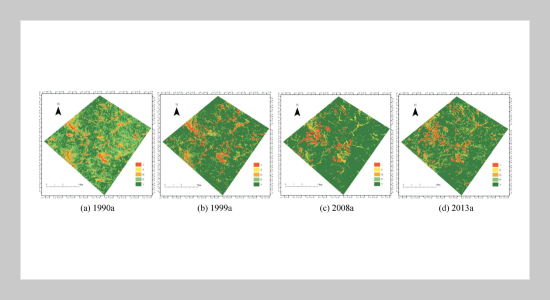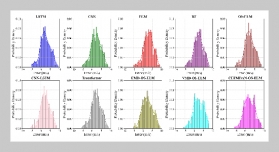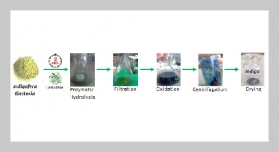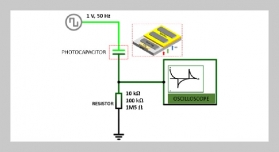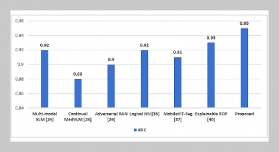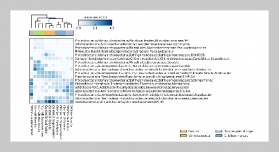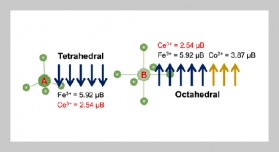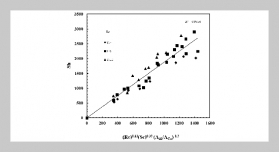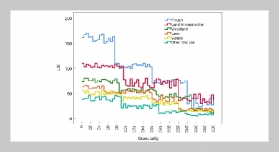Hengkai Li This email address is being protected from spambots. You need JavaScript enabled to view it.1, Jun Lei1 and Jiao Wu1 1Department of Architecture and Surveying Engineering, Jiangxi University of Science and Technology, Ganzhou, Jiangxi 341000, P.R. China
Received:
June 10, 2017
Accepted:
March 16, 2017
Publication Date:
September 1, 2017
Download Citation:
||https://doi.org/10.6180/jase.2017.20.3.14
More and more attentions are paid to the problems which caused by ionic rare earth mining vegetation degradation and serious ecological environment. In Lingbei rare earth mining area, Dingnan County is regarded as the research object, the Landsat images of 23a as data source, monitoring and analyzing the spatiotemporal evolution of vegetation coverage under the disturbance of rare earth mining. In order to improve the reliability of monitoring and analyzing, using dimidiate pixel model (DPM) and linear spectral mixture model (LSMM) to extract vegetation coverage of mining area, vegetation coverage extraction accuracy is validated by Pleiades image with a 0.5 m spatial resolution. The results show that: LSMM takes the spectral characteristics of unique tailings into consideration, it is more suitable for the mining area vegetation coverage extraction; from 1990 to 2013, average vegetation coverage maintains a high level; concentrating trend of the low vegetation coverage areas is very obvious, mainly for bare surface due to the pool/heap leaching rare earth mining, ecological problem is still serious; vegetation degradation mainly caused by rare earth mining, in-situ leaching reduced the direct destruction of surface vegetation, but due to leakage of leaching liquid inevitably, may lead to a greater range of vegetation degradation; average vegetation coverage of each year increased with the mining area as the center, the effect area of coverage involves around 300 to 400 m, in-situ leaching on the surrounding vegetation effect is less than tank/heap leachingABSTRACT
Keywords:
Vegetation Coverage, Rare Earth Ions, Linear Spectral Mixture, Spatial-temporal Evolution
[1] Li, H. K., Wu, L. X. and Liu, X. S., “Change Detection of Ground-surface Environment in Rare Earth Mining Area Base on Multi-temporal Remote Sensing: a Case in Lingbei Rare Earth Mining Area,” Journal of China University of Mining and Technology, Vol. 43, No. 6, pp. 10871095 (2014). doi: 10.13247/j.cnki.jcumt.000260 [2] Xiao, Z. J., Liu, Z. W. and Zhang, N., “Environmental Impact Analysis and Control Technology of Ionic Rare Earth Mining in South of Jiangxi Province,” Chinese Rare Earth, Vol. 35, No. 6, pp. 5662 (2014). (Chinese) [3] Wang, J. M., Guo, L. L., Bai, Z. K., Yang, R. X. and Zhang, M., “Succession Law of Reclaimed Soil and Vegetation on Opencast Coal Mine Dump of Loess Area,” Transactions of the Chinese Society of Agricultural Engineering, Vol. 29, No. 21, pp. 223232 (2013). doi: 10.3969/j.issn.1002-6819.2013.21.028 [4] Li, H. K., Liu, X. S., Li, B. and Li, F. S., “Vegetation Coverage Variations and Correlation with Geomorphologic Factors in Red Soil Region: a Case in South Jiangxi Province,” Scientia Geographica Sinica, Vol. 34, No. 1, pp. 103109 (2013). doi: 10.13249/j.cnki. sgs.2014.01.003 [5] Cai, H., Wang, J. G., Yang, R. X., Li, C., Ji, W. and Wang, X. Y., “Analysis of Spatiotemporal Change of Qiemo Oasis Vegetation Coverage Based on FCD Model,” Remote Sensing for Land and Resources, Vol. 25, No. 2, pp. 131137 (2013). doi: 10.6046/gtzyyg. 2013.02.22 [6] Liao, Q. F., Zhang, X., Ma, Q., Yao, Y. and Yu, D. P., “Spatiotemporal Variation of Fractional Vegetation Cover and Remote Sensing Monitoring in the Eastern Agricultural Region of Qinghai Province,” Acta Ecologica Sinica, Vol. 34, No. 20, pp. 59365943 (2014). doi: 10.5846/stxb201301230138 [7] Huang, Y., Wang, Y. J., Li, X. S., Hu, Z. L. and Liu, G. P., “Graphic Analysis of Spatio-temporal Effect for Vegetation Disturbance Caused by Coal Mining: a Case of Datong Coal Mine Area,” Acta Ecologica Sinica, Vol. 33, No. 21, pp. 70357043 (2013). doi: 10.5846/stxb201207080952 [8] Jiang, Z. Y., Alfredo, R. H., Chen, J., Chen, Y. H., Li, J., Yan, G. J. and Zhang, X. Y., “Analysis of NDVI and Scaled Difference Vegetation Index Retrievals of Vegetation Fraction,” Remote Sensing of Environment, Vol. 101, No. 3, pp. 366378 (2006). doi: 10.1016/ j.rse.2006.01.003 [9] Wu, J., Liu, M. S. and Li, W. T., “Research on Vegetation Cover Information Extraction Technologies under Different Terrain Conditions,” Chinese Journal of Plant Ecology, Vol. 37, No. 1, pp. 1825 (2013). doi: 10.3724/SP.J.1258.2013.00002 [10] Cheng, H. F., Zhang, W. B. and Cheng, F., “Advances in Researches on Application of Remote Sensing Method to Estimating Vegetation Coverage,” Remote Sensing for Land and Resources, No. 1, pp. 1318 (2008). (Chinese) [11] Fan, F. L., Fan, W. and Weng, Q. H., “Improving Urban Impervious Surface Mapping by Linear Spectral Mixture Analysis and Using Spectral Indices,” Canadian Journal of Remote Sensing, Vol. 41, pp. 110 (2015). doi: 10.1080/07038992.2015.1112730 [12] He, Z., Liu, L., Deng, R. R. and Shen, Y., “Low-rank Group Inspired Dictionary Learning for Hyperspectral Image Classification,” Signal Processing, Vol. 120, pp. 209221 (2016). doi: 10.1016/j.sigpro.2015.09.004 [13] Cui, T. X., Gong, Z. N., Zhao, W. J., Zhao, Y. L. and Lin, C., “Research on Estimating Wetland Vegetation Abundance Based on Spectral Mixture Analysis with Different Endmember Model: a Case Study in Wild Duck Lake Wetland, Beijing,” Acta Ecologica Sinica, Vol. 33, No. 4, pp. 11601171 (2013). doi: 10.5846/ stxb201204270604 [14] LI, X. S., Gao, Z. H., Li, Z. Y., Bai, L. N. and Wang, B. Y., “Estimation of Sparse Vegetation Coverage in Arid Region Based on Hyperspectral Mixed Pixel Decomposition,” Chinese Journal of Applied Ecology, Vol. 21, No. 1, pp. 152158 (2012). doi: 10.13287/j.1001- 9332.2010.0041 [15] Wang, C., Du, H. Q., Zhou, G. M., Xu, X. J., Sun, S. B. and Gao, G. L., “Retrieval of Crown Closure of Moso Bamboo Forest Using Unmanned Aerial Vehicle (UAV) Remotely Sensed Imagery Based on Geometric-optical Model,” Chinese Journal of Applied Ecology, Vol. 26, No. 5, pp. 15011509 (2015). doi: 10.13287/j. 1001-9332.20150302.001 [16] Xu, H. Q., “Dynamics of Bare Soil in a Typical Reddish Soil Loss Region of Southern China: Changting County, Fujian Province,” Scientia Geographica Sinica, Vol. 33, No. 4, pp. 489487 (2013). doi: 10.13249/ j.cnki.sgs.2013.04.008 [17] Zhang, Z. Z., Problems and Countermeasures of Dingnan County Forestry Management, Ph. D. Desertation, Nanchang University, China (2009). [18] Peng, Y., He, G. J., Zhang, Z. M., Jiang, W., Quang, Z. Y. and Wang, Z. Y., “Eco-environmental Dynamic Monitoring and Assessment of Rare Earth Mining Area in Southern Ganzhou Using Remote Sensing,” Acta Ecologica Sinica, Vol. 36, No. 6 (2016). doi: 10.5846/stxb201408181632 [19] Cheng, X., Cai, Q. Y., Yu, X. S., Liu, Y. Z., Ge, G., Wu, L. and Wang, X. F., “Vertical Distributions of Soil Environmental Factors in Ion-type Rare Earth Mining of Southern Jiangxi: a Case Study in Longnan Rare Earth Mining Area,” Chinese Rare Earth, Vol. 36, No. 1, pp. 2328 (2015).REFERENCES


